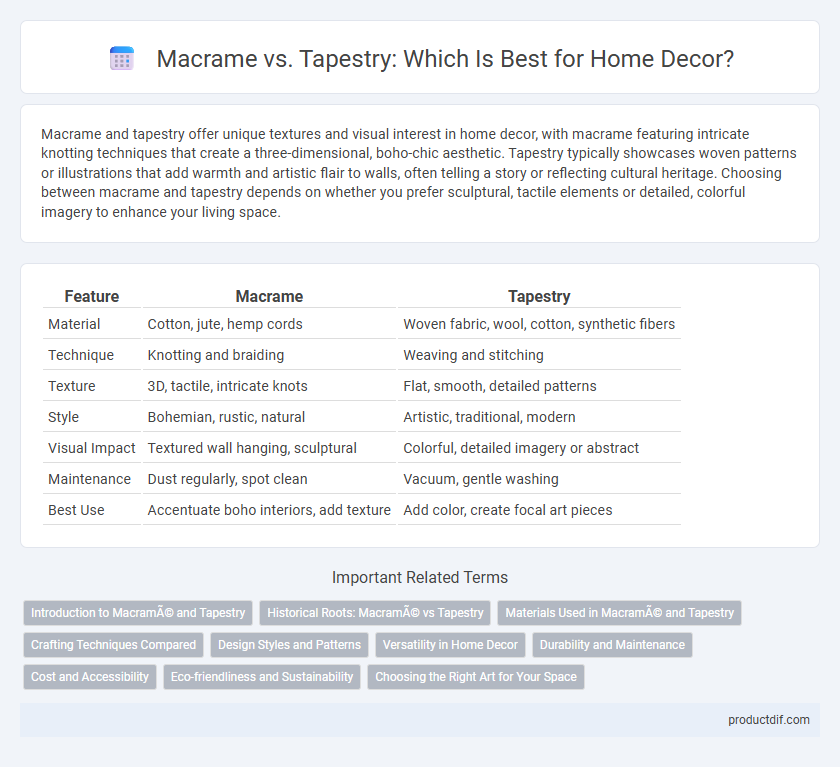Macrame and tapestry offer unique textures and visual interest in home decor, with macrame featuring intricate knotting techniques that create a three-dimensional, boho-chic aesthetic. Tapestry typically showcases woven patterns or illustrations that add warmth and artistic flair to walls, often telling a story or reflecting cultural heritage. Choosing between macrame and tapestry depends on whether you prefer sculptural, tactile elements or detailed, colorful imagery to enhance your living space.
Table of Comparison
| Feature | Macrame | Tapestry |
|---|---|---|
| Material | Cotton, jute, hemp cords | Woven fabric, wool, cotton, synthetic fibers |
| Technique | Knotting and braiding | Weaving and stitching |
| Texture | 3D, tactile, intricate knots | Flat, smooth, detailed patterns |
| Style | Bohemian, rustic, natural | Artistic, traditional, modern |
| Visual Impact | Textured wall hanging, sculptural | Colorful, detailed imagery or abstract |
| Maintenance | Dust regularly, spot clean | Vacuum, gentle washing |
| Best Use | Accentuate boho interiors, add texture | Add color, create focal art pieces |
Introduction to Macramé and Tapestry
Macrame is a textile art form that involves knotting cords or strings into intricate patterns to create decorative items like wall hangings, plant holders, and cushions, celebrated for its bohemian and textured aesthetic. Tapestry, on the other hand, is a woven fabric traditionally produced on a loom, used to depict detailed images or patterns, offering rich color and elaborate storytelling through threads. Both macrame and tapestry serve as versatile home decor elements that add warmth, texture, and artistic expression to interior spaces.
Historical Roots: Macramé vs Tapestry
Macrame originates from 13th-century Arabic weavers who used intricate knotting techniques to create decorative textiles, emphasizing craftsmanship and portability. Tapestry dates back to ancient Egypt and flourished in medieval Europe, characterized by woven images depicting historical or religious narratives on large fabric panels. Both art forms reflect distinct cultural histories, with macrame focusing on knot patterns and tapestries showcasing pictorial weaving.
Materials Used in Macramé and Tapestry
Macrame primarily uses natural fibers such as cotton, jute, hemp, and sometimes synthetic cords, offering a durable and textured finish ideal for wall hangings and plant holders. Tapestries are woven from wool, silk, cotton, and sometimes metallic threads, providing intricate patterns and rich colors that create a warm, artistic focal point in home decor. The choice of materials in macrame emphasizes knotting techniques for structure, while tapestry fibers focus on weaving for detailed imagery.
Crafting Techniques Compared
Macrame involves knotting cords or strings into intricate patterns, creating textured, three-dimensional wall hangings that add depth to home decor. Tapestry weaving uses a loom to interlace threads, producing flat, detailed images or patterns rich in color and design complexity. Both crafts rely on different manual techniques, with macrame emphasizing knotting skills and tapestries focusing on weaving precision.
Design Styles and Patterns
Macrame features intricate, knotted designs often showcasing bohemian and rustic aesthetics with geometric or floral patterns. Tapestries display woven or printed fabric art, offering vibrant, detailed imagery that suits eclectic or traditional decor styles. Both design styles bring texture and visual interest, enhancing the ambiance through their unique craftsmanship.
Versatility in Home Decor
Macrame offers intricate knot patterns and textural depth, making it ideal for adding a bohemian or rustic touch to various spaces such as living rooms, bedrooms, and even outdoor areas. Tapestries provide vibrant, large-scale artwork that can instantly become a focal point on walls, enhancing color schemes and thematic elements in diverse interior styles. Both macrame and tapestries serve versatile functions, from wall hangings and curtains to room dividers and decorative accents, adapting seamlessly to eclectic or modern home decor aesthetics.
Durability and Maintenance
Macrame, crafted from tightly knotted cotton or hemp cords, offers excellent durability and resists fraying, making it ideal for long-term home decor. Tapestry, typically woven from wool or synthetic fibers, requires more careful maintenance, such as delicate cleaning and protection from sunlight to prevent fading and damage. Choosing macrame provides easier upkeep and resilience, while tapestries demand attentive care to preserve intricate designs and vibrant colors.
Cost and Accessibility
Macrame offers a more budget-friendly option for home decor enthusiasts, with DIY kits and materials readily available at craft stores and online retailers. Tapestries, often woven or printed with intricate designs, tend to be pricier due to craftsmanship and material quality, making them less accessible for quick or low-cost decorating. Both styles provide unique textural elements, but macrame's affordability and widespread availability make it a popular choice for those seeking creative and economical decor solutions.
Eco-friendliness and Sustainability
Macrame and tapestry both offer eco-friendly options for home decor, with macrame often crafted from natural fibers like cotton or jute, promoting biodegradability and reduced environmental impact. Tapestries, traditionally woven from organic materials such as wool or linen, provide sustainable durability and can incorporate recycled textiles, enhancing resource efficiency. Opting for handmade macrame or tapestry pieces supports artisanal craftsmanship and reduces reliance on mass-produced, synthetic decor products.
Choosing the Right Art for Your Space
Macrame offers a textured, bohemian vibe with its intricate knot patterns, perfect for adding warmth and dimension to minimalist or rustic interiors. Tapestries feature vibrant, woven designs that can introduce color and storytelling elements, making them ideal for large, blank walls in eclectic or traditional rooms. Selecting between macrame and tapestry depends on your desired aesthetic impact, wall space, and the mood you want to create within your home decor.
Macramé vs Tapestry Infographic

 productdif.com
productdif.com